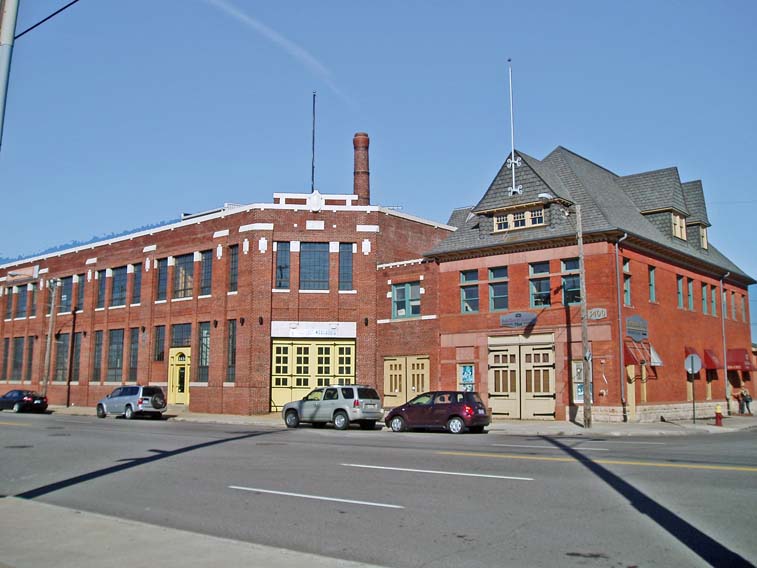

The property where these buildings are located was, in 1827, beyond the settled area of Detroit. The city established a Potter’s Field here which became known as City Cemetery.
As Detroit grew in the post-Civil War era, the city decided to remove those buried here so that the land could be used for other purposes. They were reinterred on the distant east side near the intersection of Gunston and Hern streets where they were forgotten for many decades. New construction in the post-World War II uncovered the remains of those who had been buried along Russell a century earlier.
In 1867, the state legislature authorized the creation of a professional firefighting force in Detroit. In 1870, a market for the sale of wood and hay was established along Russell near this point. The city was growing and its residents needed to buy hay for their horses and wood to heat their residences, as well as farm products. By 1885 the Eastern Market was well established in this area where it still enjoys commercial success. The oldest of the standing building in the Eastern Market dates from 1885 and the oldest shed from 1898. That impressive brick shed was designed by the architect who designed the Detroit Fire Department Repair Shop, Richard Raseman. Prior to the automobile age, hay may have been the principal product sold here.
In the mid-1880s, the city decided that some of the unused area of the former Potter’s Field should be devoted to new facilities for the Fire Department. The brick firehouse that you see opened in 1888. The department, at this time, had more than 100 horses in service. The Department, apparently, strictly enforced weight and skill requirements on their horses. Those serving on a team to pull a hose wagon had to weigh 1,100 pounds, those pulling a steam pumper had to exceed 1,400 pounds and those pulling the hook and ladder wagon had a minimum weight of 1,700. I infer that horses were specially trained as a paid.
From time to time, epizootics broke out in large American cities. This was a tremendous problem for fire department and seriously crippled public transit in the years before electric street cars. At one time an epizootic incapacitated most of the fire horses in Buffalo and, in 1872, a fire in Boston destroyed 776 building. The fire department there was greatly handicapped since their horses were sick. Thus the conflagration was identified as the Epizootic Fire of 1872. For these reasons, the Detroit Fire Depart built a brick hospital for horses in conjunction with this fire house. Before going into service, horses were taught to accelerate quickly whenever the siren sounded. So a 700-foot-long training track was also constructed near this fire house.
In 1908, the Detroit Fire Department purchased their first motorized vehicle. Shortly thereafter, they bought many more fire trucks and, by 1915 or so, they needed a large facility to maintain their equipment so the building you see pictured above was constructed. In April, 1922; the Detroit Fire Department made its last run using horses.
The building of Hook and Ladder No. 5 was used until 1956 when the company moved to a new structure also located on Russell. The building pictured above is a two-story rectangular—30 feet by 70 feet—structure with a full story of usable space under the steeply pitched hip roof. The original large wood swing doors were boarded by banding and red sandstone quoins. As was typical in the late Nineteenth Century, this building sits upon a very imposing rock-faced limestone foundation. This is the second oldest firehouse standing in Detroit. The oldest standing firehouse, Engine House Number 11, is nearby at Gratiot and Grandy. It opened in 1883 but is no longer in use.
The much newer Detroit Fire Department Repair Shop is a large building—170 feet by 65 feet. There are eight bays facing Russell Street and throughout, you see much terra cotta ornamentation. The building was remodeled and additions were built in 1921, 1922 and 1934. The brick stable building and hospital were torn down to provide space for the expansion of this repair shop. The Detroit Fire Department and the Detroit Department of Public Works continued to use this building into the mid-1990s. Both of these buildings have been successfully converted into commercial properties.
Hook and Ladder No. 5
Architects: William Malcomson and William Higginbottham
Date of Completion: 1888
Architectural style: Late Victorian
Use in 2013: Sala Thai Restaurant
Website for Sala Thai Restaurant: http://www.salathaidetroit.com/
Detroit Fire Department Repair Shop
Architects: Richard Raseman
Date of Completion: 1917
Use in 2013: This is now the FD Lofts Building. The lofts, I believe, are not residential. Rather they office space for various businesses.
Report of the City of Detroit Historic Designation Board:
http://www.detroitmi.gov/LinkClick.aspx?fileticket=HwZw9KSNGZc%3d&tabid=3096&mid=4357
City of Detroit Designated Historic District: Listed 2004
State of Michigan Registry of Historic Sites: P25,155 Listed June 19, 1975
National Register of Historic Places: Listed December 1, 1997
Photographs: Ren Farley; October 2013
Description prepared: December, 2013